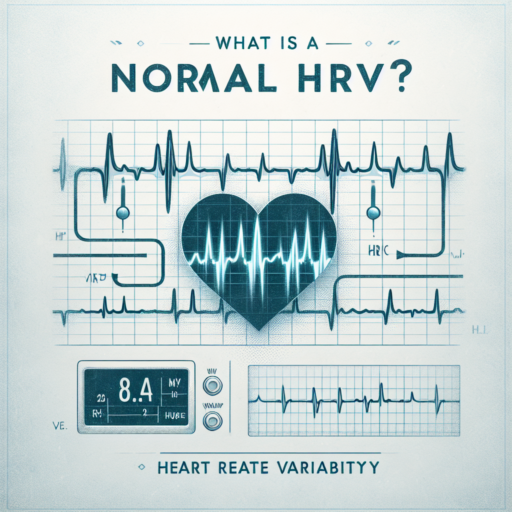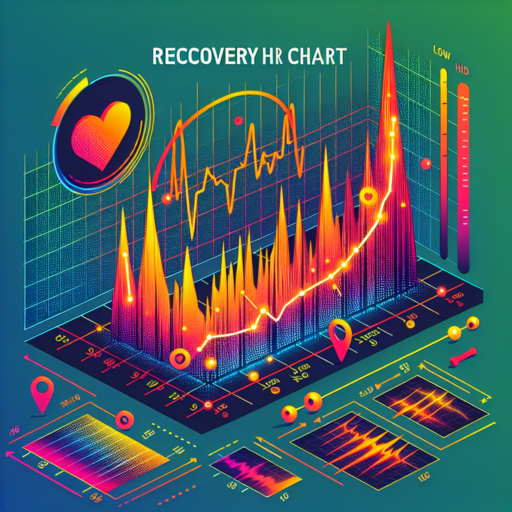No se han encontrado productos.
Understanding HRV: An Introduction
Heart Rate Variability (HRV) is a crucial metric that provides deep insights into our overall well-being and fitness. At its core, HRV measures the variation in time between consecutive heartbeats, offering a window into the autonomic nervous system’s (ANS) dynamics. This variation is normal and indicates a healthy balance between the sympathetic nervous system (the body’s stress response) and the parasympathetic nervous system (the body’s relaxation response).
Furthermore, HRV is not just a simple health marker; it’s a powerful tool for personal health monitoring and optimization. By understanding the nuances of HRV, individuals can tailor their exercise, stress management, and recovery practices more effectively. For athletes, HRV is especially critical as it helps to gauge training load and recovery status, enabling fine-tuned sports performance enhancements.
In the context of stress management and mental well-being, HRV plays a pivotal role. A higher HRV is often associated with a greater ability to handle stress, improved cardiovascular health, and increased resilience to challenges. Conversely, lower HRV levels may indicate stress, overtraining, or even potential health issues that need attention. Therefore, monitoring HRV can empower individuals to make informed decisions about lifestyle adjustments, stress reduction techniques, and recovery strategies.
What is a Normal Heart Rate Variability (HRV)?
Understanding Heart Rate Variability (HRV) is essential for anyone interested in monitoring their cardiovascular health. HRV refers to the variation in the time interval between consecutive heartbeats. It is a measure that can indicate your body’s ability to adapt to stress, exercise, and disease. A normal HRV can differ significantly among individuals, making it important to know what could be considered a healthy range for you.
Typically, a normal HRV score for adults can range anywhere from 20 to 200 milliseconds. This wide range is due to various factors, including age, fitness level, and overall health. Generally, a higher HRV suggests a healthier heart and a higher level of cardiac fitness. It implies that your heart is able to adapt and respond efficiently to varying stressors and demands. However, interpreting HRV should be done considering an individual’s baseline measurements and in consultation with a healthcare professional.
To get a clearer picture of what constitutes a normal HRV for you, it’s beneficial to monitor your HRV over time. This can help establish your average baseline, from which deviations might indicate changes in stress levels, health, or lifestyle impacts. Technology, such as wearable heart rate monitors, has made it easier than ever to track this data consistently. Regular monitoring can provide valuable insights into how different aspects of your life influence your heart’s variability and overall wellbeing.
Factors That Influence Your HRV
Understanding the dynamics of Heart Rate Variability (HRV) and the factors influencing it is crucial for optimizing health and performance. HRV measures the variation in time between each heartbeat, reflecting the body’s ability to adapt to stress and environmental changes. Several key components play a significant role in affecting your HRV, offering insights into your overall wellbeing and fitness levels.
Physical Activity and Exercise
The level and intensity of physical activity significantly impact HRV. While regular, moderate exercise is known to improve HRV by enhancing the heart’s efficiency and vagal tone, excessive training without adequate recovery can lead to a decrease in HRV, signaling potential overtraining and fatigue. Thus, balancing exercise and rest is essential for optimal heart health and HRV.
Stress and Emotional State
Stress and emotions carry a profound effect on HRV, with acute or chronic stress often resulting in lower variability. The body’s stress response, mediated by the sympathetic nervous system, can suppress HRV as it prepares for a «fight or flight» reaction. Conversely, positive emotions and relaxation techniques such as meditation and breathing exercises can increase HRV, reflecting a state of calm and resilience against stressors.
Sleep Quality
Good sleep is paramount for a healthy HRV. The quantity and quality of sleep can either improve or impair HRV, illustrating the restorative power of sleep on the autonomic nervous system. Inadequate or fragmented sleep has been associated with lower HRV scores, linking poor sleep patterns to increased stress levels and reduced cardiovascular health. Therefore, prioritizing sleep is a cornerstone for enhancing HRV.
How to Measure Your HRV Accurately
Measuring your Heart Rate Variability (HRV) accurately is crucial for understanding your body’s stress levels, recovery status, and overall health. HRV refers to the variation in time between each heartbeat, which is considered a powerful indicator of your autonomic nervous system’s balance. To ensure precise measurements, several key factors and methods must be considered.
Choose the Right Tool
For accurate HRV readings, selecting an appropriate device is essential. This typically includes wearable technology like smartwatches and fitness trackers that support HRV metrics, or dedicated HRV monitors designed specifically for this purpose. Ensure the device is validated for HRV accuracy by checking scientific reviews or user feedback.
Standardize Measurement Conditions
To obtain reliable HRV data, it’s critical to measure under consistent conditions. Preferably, HRV should be measured at the same time each day, especially after waking up, as this offers a baseline reflective of your body’s rested state. Avoid measuring during or immediately after exercise, when your heart rate is elevated and could skew results. Ensuring a relaxed state in a comfortable position for at least 5 minutes before taking a measurement can also help in achieving accurate readings.
Maintaining a routine that includes regular monitoring under standardized conditions is beneficial for tracking changes in your HRV over time. By observing these protocols and using the right tools, you can achieve accurate HRV measurements that are truly reflective of your physiological condition, supporting better health and wellness decisions.
The Relationship Between HRV and Overall Health
The connection between Heart Rate Variability (HRV) and overall health has garnered significant attention in the field of wellness and medical science. HRV, a measurement of the time variation between heartbeats, is gaining prominence as a crucial indicator of the autonomic nervous system’s performance and heart health. Understanding how HRV relates to overall health can empower individuals with insights into their cardiovascular system, stress levels, and recovery state.
Research indicates that a high HRV is often associated with robust cardiovascular fitness and a resilient stress response system. Essentially, when your HRV is high, your body is considered to be in a better state to manage stress and recover from physical exertion. On the contrary, a low HRV can signal an overstressed system, poor recovery, and even the risk of developing cardiovascular diseases. This fundamental knowledge underscores the importance of monitoring HRV within the context of improving or maintaining optimal health.
Key Components Influencing HRV and Health
- Physical Activity: Regular, moderate exercise can enhance HRV, suggesting an improvement in heart health and stress management abilities.
- Stress Management: Effective stress control through mindfulness, meditation, or cognitive behavioral strategies can positively affect HRV, reflecting an individual’s capacity to handle stress.
- Sleep Quality: Adequate and restful sleep is closely linked with higher HRV scores, highlighting the role of sleep in recovery and overall vitality.
Moreover, lifestyle factors such as diet, hydration, and abstinence from harmful habits like smoking can all substantially influence HRV and, subsequently, general health. These insights into HRV’s role in health elucidate the interconnectedness of bodily systems and the importance of a holistic approach to health and wellness. Mapping out the relationship between HRV and overall health offers a compelling avenue for both healthcare professionals and individuals to explore strategies aimed at enhancing wellbeing through heart rate variability optimization.
Improving Your HRV: Tips and Tricks
Heart Rate Variability (HRV) is a critical measure of your autonomic nervous system function and overall well-being. If you’re looking to improve your HRV for better health and stress management, incorporating some key practices into your daily routine can make a significant difference. Here, we’ll explore actionable tips and tricks to enhance your HRV effectively.
Optimize Your Sleep Quality
One of the most impactful ways to boost your HRV is by optimizing your sleep quality. A restful night’s sleep plays a pivotal role in autonomic nervous system recovery, directly influencing your HRV scores. Aim for 7-9 hours of quality sleep by establishing a consistent bedtime routine, limiting exposure to blue light in the evenings, and ensuring your sleeping environment is quiet, dark, and cool.
Incorporate Regular Exercise
Exercise is another vital component in improving your HRV. Engaging in a mix of cardiovascular exercises, strength training, and especially activities that promote relaxation such as yoga, can enhance your heart’s resilience and its ability to manage stress. Moderate intensity is key — find a balance that challenges you without causing undue stress, as overtraining can negatively impact your HRV.
Mindful Breathing and Meditation
Breathing exercises and meditation not only reduce stress but also improve HRV by stimulating the vagus nerve, which controls heart rate variability. Starting with as little as five minutes of guided meditation or mindful breathing each day can lead to noticeable changes in HRV over time. Techniques such as the 4-7-8 breathing method or using a meditation app can be effective starting points for beginners.
Common Misconceptions About HRV Explained
When discussing Heart Rate Variability (HRV), a multitude of misconceptions arise, clouding the true understanding and benefits of this health metric. HRV, a measure of the variability in time between each heartbeat, is often misunderstood in terms of its implications and how it can be influenced. This segment aims to clarify some of the most common misunderstandings surrounding HRV.
The Significance of High vs. Low HRV
One prevalent misconception is that a higher HRV is always indicative of better health. While it’s true that higher HRV can be associated with greater cardiovascular fitness and stress resilience, this isn’t a one-size-fits-all marker. Individual baseline levels vary significantly, meaning a lower HRV could be normal for some and may not necessarily signal poor health. It’s essential to consider personal health contexts and consistent measurement for accurate interpretation.
HRV and Physical Fitness
Another misunderstanding is the direct correlation between HRV and physical fitness. While there is a link between high HRV and cardiovascular health, suggesting that individuals with greater fitness levels always have higher HRV metrics is misleading. Various factors, including stress, sleep quality, and genetic predispositions, play substantial roles in determining one’s HRV. Consequently, it’s critical not to solely rely on HRV as an indicator of fitness but to look at it as part of a broader health assessment.
In distinguishing fact from fiction regarding HRV, education and awareness are key. By understanding what HRV actually reflects about our body’s physiological state and recognizing the influence of individual differences, we can better interpret this valuable metric and integrate it effectively into health and wellness practices.
HRV: The Impact of Age, Fitness, and Stress
The relationship between HRV (Heart Rate Variability) and factors such as age, fitness level, and stress is complex and illuminating. HRV, a measure of the variation in time between each heartbeat, is widely recognized as a crucial indicator of cardiovascular and autonomic nervous system health. Understanding how age, fitness, and stress levels impact HRV can offer invaluable insights into one’s overall well-being and physiological resilience.
Age and HRV
Age has a significant influence on HRV, with evidence suggesting a natural decline in HRV as one ages. This decline is thought to reflect the physiological changes that occur with aging, including a decrease in the flexibility of the heart and blood vessels. However, this is not an immutable fact of aging; lifestyle choices and proactive health measures can mitigate its effects. Engaging in regular physical activity, for instance, has been shown to help preserve HRV even as one ages, demonstrating the plasticity and resilience of the human body.
Fitness Levels and HRV
Fitness levels have a profound effect on HRV, with numerous studies highlighting the positive correlation between high levels of physical fitness and increased HRV. Regular exercise enhances autonomic regulation of the heart, improving both sympathetic and parasympathetic responses. This improvement in autonomic balance is reflected in higher HRV scores, showcasing the benefits of a consistently active lifestyle on cardiovascular health.
Stress and HRV
Stress, particularly when chronic, exerts a negative impact on HRV, signaling an imbalance in the autonomic nervous system’s control over the heart. Stressful conditions lead to an increased sympathetic response (fight or flight) and a decreased parasympathetic response (rest and digest), resulting in lower HRV scores. Implementing stress management techniques, such as mindfulness and deep breathing exercises, can help in restoring autonomic balance and, consequently, improving HRV. This underlines the critical role of mental health in maintaining physiological health and resilience.
Using HRV Data to Enhance Your Fitness Regimen
Understanding how to leverage Heart Rate Variability (HRV) data can be a game-changer for anyone looking to optimize their fitness regimen. HRV measures the time variation between heartbeats and is a critical indicator of autonomic nervous system function and overall cardiovascular health. Integrating HRV data into your fitness routine can help in fine-tuning workout intensity, timing, and recovery periods, ensuring that each session is as efficient as possible.
One of the key benefits of using HRV data is its ability to signal overtraining and under-recovery. For athletes and fitness enthusiasts, recognizing the signs of fatigue and adapting workout plans accordingly can prevent burnout and injury. By monitoring daily HRV scores, individuals can make informed decisions about whether to proceed with high intensity training or allow for more recovery time. This personalized approach to training helps in maximizing performance while minimizing the risk of setbacks.
Practical Steps to Integrate HRV into Your Fitness Regimen
- Begin by tracking your HRV daily using a reliable fitness tracker or smartwatch.
- Analyze the data trends over time to understand your baseline HRV score.
- Adjust your workout intensity based on highs and lows in your HRV readings.
- Incorporate active recovery sessions when your HRV data indicates elevated stress or fatigue levels.
Implementing HRV data into your fitness strategy not only optimizes workout effectiveness but also elevates your ability to tune in to your body’s needs. As you learn to interpret and act on your HRV readings, you’ll find it easier to align your fitness goals with your physiological signals, ensuring a holistic approach to health and wellbeing.
HRV Monitoring Devices: What You Need to Know
Understanding the nuances of HRV (Heart Rate Variability) monitoring devices is crucial in today’s health-conscious world. HRV monitoring has become a vital tool for athletes, wellness enthusiasts, and health professionals alike. It offers insights into the autonomic nervous system’s functioning, reflecting on one’s stress levels, recovery status, and overall cardiac health. With the vast array of devices available, choosing the right one can be daunting.
At its core, HRV refers to the variation in time intervals between heartbeats, which is considered a key indicator of cardiovascular health and stress management. Effective HRV monitoring devices measure these intervals precisely, providing data that can help tailor fitness and wellness regimens more accurately. The technology behind these devices ranges from wearables, like smartwatches and fitness bands, to more specialized medical-grade equipment. Each type serves different needs, from everyday fitness tracking to detailed health diagnostics.
When exploring HRV monitoring devices, it’s important to consider several factors: accuracy, usability, and the depth of data analysis offered. Accuracy is paramount, as the insights drawn from these devices directly impact one’s health decisions. Usability encompasses everything from how comfortably a device can be worn to the intuitiveness of its interface. Lastly, the depth of data analysis—how detailed and accessible the information is—can vary significantly across devices, impacting their effectiveness in improving health outcomes.




